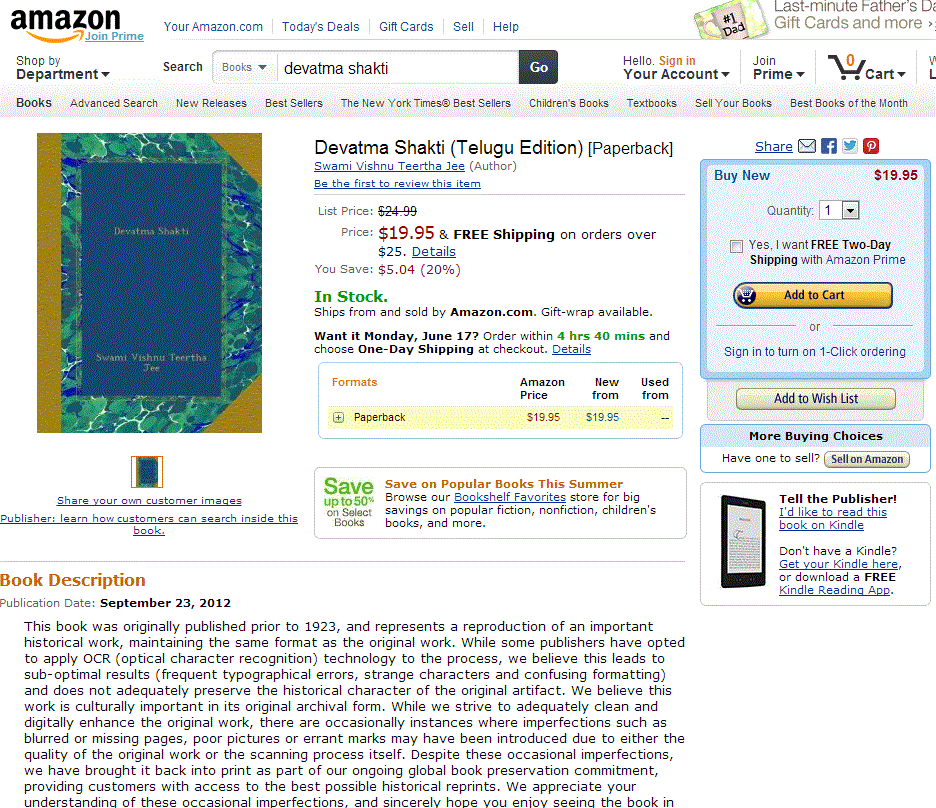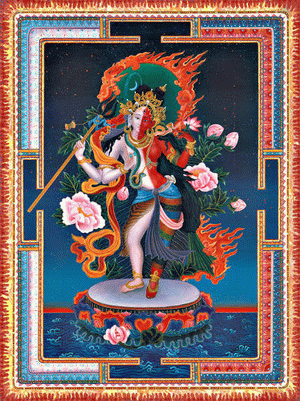
His Holiness Shree Swami Vishnu Tirtha
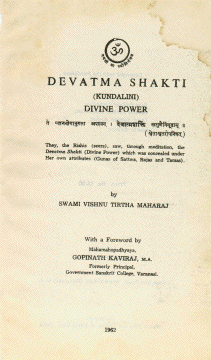
The following is from: Adhyatmajyoti.org
8 Coury Road,
Hillsborough, NJ 08844, USA
Phone No.: (908)-369-1571
E-mail: nkumarom@aol.com
KUNDALINI SHAKTI AND SHAKTIPAT DEEKSHA
The science of Kundalini is basically tantric. In former days tantra was an extremely powerful science. There are three main disciplines in it; “divyachar” for practitioners of satva-guna, “virachar” for practitioners of rajo-guna and “pashvachar” for practitioners of tamo-guna. The activities of unqualified practitioners of “Virachar” and specially “pashvachar” have badly damaged the image of tantra and have earned bad name for it. Accordingly they have disappeared. Kundalini Yoga comes under “divyachar,” but with the association of the name of tantra with it too it is nearly disappearing gradually and is becoming distorted and ineffective.
In the scriptures of tantra Kundalini Shakti is much talked about. What is normally said about it is its form like a snake that is sitting with three-and-a-half coils, biting its own tail, and sleeping such that the entrance of sushumna nerve in the root center is enclosed by it. This is extremely powerful divine energy, on who’s awakening and becoming active the closed mouth of Brahma-nerve sushumna opens up. Then this energy enters in it, pierces the six charkas known as mooladhar, swadhishthan, manipur, anahat, vishuddha and agya, reaches the sahasrar chakra, becomes one with Shiva along with jivatma upon which jivatma becomes free from the bondage and assumes the form of Paramatma itself.
Besides the tantric scriptures it has also been described in the Vedic Upanishads as the “science of Brahma” and there are several methods prescribed for its awakening. All the sciences described as “vidya sambhuti” in Ishavasya Upanishad, as “hemvati” in Ken, as “Aditi” in Katha, as “prana-vidya, para-vidya” in Prashna, as “OM-kara” in Mandukya, as “yoga-vidya” in Aitreya, as “bhargavi varuni” in Taittariya, as “udgeeth, prana, antaraditya, gayatri, shandilya, antaryami, dahar, madhu, samvarga, panchagni, vaishvanar sciences” in Chandogya and Brahadaranyaka, as “devatma shakti, savita” in Shvetashvatara and as “balaki vidya” in Kaushitaki Upanishad are different social and customary names and forms of the same divine energy.
In this journey from mooladhara chakra to sahasrara there is a vivid and very attractive description of every different form of the chakra and its petals, syllables marked on them, devas seated in them and about the availability of transcendental divine sciences, energies and siddhis through them. This energy is capable of giving both—all kinds of grandeur (greatness) through all possible means and liberation. Nine forms of Goddess i.e. hemvati, shreevidya, brahmi, saraswati, lakshmi, navadurga and the like are all said to be the different forms of the awakening of this energy. This is also the basis of the creation of jiva.
What this energy is in fact? We find a description of uchhisht-Brahm in the Upanishads. Uchhisht means the “remains after the use.” In the construction of all the elements of the creation only one-fourth part of Para-Brahma Paramatma has been used, its three-fourth part is yet the divine nectar in the form of the basis of the creation—“Padoasya sarva bhutani tripadsyamratam divi”—Chha. U., 3-12-6. This itself is said to be uchhisht-Brahm, which is simply actionless, without attributes and uninvolved starting basis. This only has been described in Puranas as Shesh Naag (snake) holding the Earth on its head. Just as the basic padding of a huge building always remains unseen, even so this too remains unseen; it is never seen.
In the same way the energy saved after jivatma’s own creation should be understood to be the Kundalini Shakti in the form of Shesh Naagin (snake) situated in mooladhar, which is inactive, unseen, and because of being neglected it is lying asleep. There are several methods of waking it up such as chanting of mantras, pranayama, hearing of Naad (inner divine sound), bandha (locks), mudra (gestures) and asanas (yogic postures), but these methods are likely to involve great labor and uncertain long time. At the same time uncontrolled sudden awakening like an atomic blast has the possibility of dangerous and harmful opposite results.
Capable sad-Gurus can effortlessly awaken the dormant Kundalini Shakti of deserving disciples simply through their sight, resolution or touch, just as a lighted lamp effortlessly lights up another lamp. This is said to be Shaktipat Initiation.
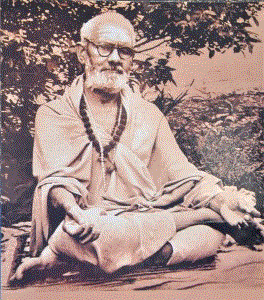
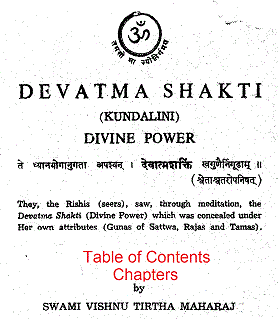

Buy Devatma Shakti on Amazon
